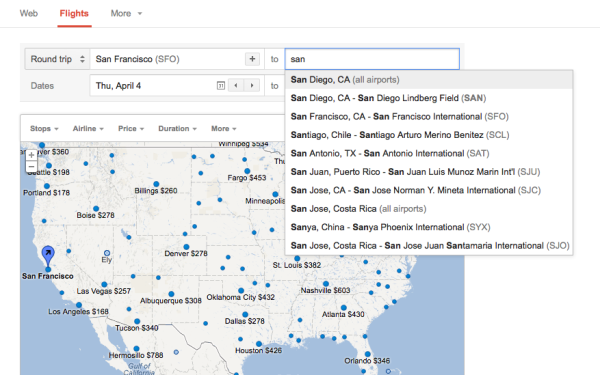Google Flight Search Takes Off Around The Globe
Google’s flight search tool had been limited to a few markets in the US. As such, it was of limited value. But last week, the company expanded flight search internationally to include 500 airports outside the US. (See postscript below below for correction.) Flight search can also be used by people in other countries — […]
 Google’s flight search tool had been limited to a few markets in the US. As such, it was of limited value. But last week, the company expanded flight search internationally to include 500 airports outside the US. (See postscript below below for correction.)
Google’s flight search tool had been limited to a few markets in the US. As such, it was of limited value. But last week, the company expanded flight search internationally to include 500 airports outside the US. (See postscript below below for correction.)
Flight search can also be used by people in other countries — UK, France, Italy, Spain or the Netherlands — to do research and initiate trip planning. In addition, Flight Search now comes in eight languages: English, French, Italian, Spanish, Basque, Catalan, Galician and Dutch and features local currency.

Perhaps the feature that’s most useful about Flight Search is the pricing information it offers. At a glance, you’re able to see what it costs to fly into different airports from your home location. If you’re flexible, you can easily discover on the tool’s map view that flying into, say, Madrid might be $100 to $200 cheaper than into Paris or London on a given date.
Another great pricing feature of Flight Search (“Flight Explorer“) allows users to see when it’s less expensive (both by month and day of the week) to fly to a desired destination. Kayak offers a somewhat comparable tool, but the presentation of the information on Google is more useful. Indeed, Flight Explorer in its new, expanded form is enormously helpful for travel planning — especially if you’re buying multiple tickets (i.e., family travel).
Flight Search is one of Google’s “vertical search” properties, though Google doesn’t see it that way. Vertical search has been at the center of controversy in the Google antitrust investigation and at the heart of competitor objections. While the US declined to pursue the vertical search issue, the Europeans have explicitly stated that it is something they want Google to address in a meaningful way.
In rolling out Flight Search in Europe, Google seems to be saying “nothing to see here” to antitrust investigators and seemingly not worried this will further complicate the company’s position or negotiations with the European Commission.
Google Flight Search is far from fully realized, but it is starting to become more useful and valuable to consumers — as well as delivering on the promise of “new experiences” that Google said it would develop when it first acquired ITA (the data source/platform behind these tools).
Postscript: Google corrected me, saying that US-based travelers have been able to book flights to 500 airports and international markets since Q1 2012. The big change is that people outside the US, in the UK, France, Italy, Spain and the Netherlands can now find flights originating within their home countries to destinations around the world.
Contributing authors are invited to create content for Search Engine Land and are chosen for their expertise and contribution to the search community. Our contributors work under the oversight of the editorial staff and contributions are checked for quality and relevance to our readers. The opinions they express are their own.
Related stories
